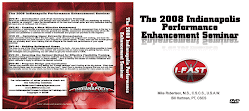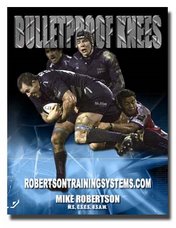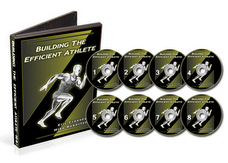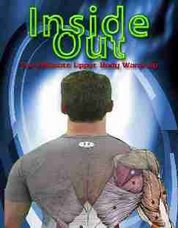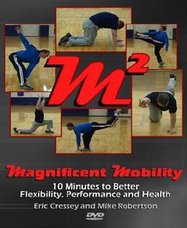High Octane Corrective Exercise and Performance Enhancement | www.RobertsonTrainingSystems.com
Wednesday, October 31, 2007
Program Design and Technique
On one hand, a good program is critical. If you have excellent form on the wrong exercises, you’re going to be consistently spinning your wheels; you’ll either make no progress, or worse yet, get injured.
On the other hand, technique is every bit as important. You could have the most amazing program in the world, geared 100% towards your every ache, pain and inefficiency. But if you perform that routine with bad technique, you’re every bit as likely to get, or stay, injured.
Program design comes down to equal parts art and science. You have to know the science to be able to utilize the art.
Technique refinement is a dynamic process – no matter how long you’ve lifted, you’ll always be refining technique.
The sooner you respect and understand the importance of each, the faster you’ll reach your training related goals.
Mike Robertson
Tuesday, October 30, 2007
Scapular Winging – Just Hide It?
In looking at his pictures it was quite apparent that he was winging badly. But what really shocked me were some of the comments.
Some of the “forumites” told him to quite worrying about it, and instead focus on building more upper back musculature so it wasn’t seen anymore! Huh? Are we still thinking like this?
Scapular winging isn’t like polio or the plague; it may not kill or cripple you, but it can wreak havoc on your shoulders. Scapular control is vitally important; if we can’t stabilize our scapulae at rest (e.g. we’re winging), what business do we have loading the shoulders with movements like overhead and bench presses?
Simple answer? No business whatsoever.
I preach efficiency for a reason. I’m not against the big exercises in any way, shape or form. What I am all about is minimizing risks and maximizing rewards.
Covering up scapular winging by “trying to put some meat on your back” is lousy advice at best. I’d imagine if this forum member followed that advice, he’d have major shoulder issues long before he ever developed his back to that degree.
Monday, October 29, 2007
Increasing Water Intake
Sedentary individuals should drink at least 2L or about 8 cups of water per day, athletes should drink at least 3L or about 12 cups of water per day, and athletes in hot weather climates drink at least 4L or about 16 cups of water per day.
Since following these recommendations can prevent dehydration and can actually assist with fat loss, you’d have to be a desiccated fool to ignore them.
However, try as they might, some individuals find it difficult to ingest up to a gallon of water per day. So try out these three proven strategies for increasing water ingestion:
1- Drink cold water – cold water is more palatable, improving “mouth feel” and ingestion
2- Add lemon – lemon increases urge to drink and also kills bacteria
3- Chuggables – always carry some sort of jug of water around to ensure you’re drinking. Rubbermaid makes a nice blue top container (Chuggables) that we recommend to our clients.
If you like this tip and want to learn more about JB and his products, check out his Precision Nutrition website.
Wednesday, October 24, 2007
Use the "Muscle Beach" Effect!
Tuesday, October 23, 2007
Mood Eating
Most people eat based on their mood and/or some subjective feelings of hunger. They don’t eat based on what their bodies need. Think of it this way: you’re about to take a long drive on a stretch of highway with no gas station. Do you fail to stop for gas before you hit the road because you’re "not in the mood?" Of course not. Think of eating in the same way. Eating fuels your metabolic engine. So it’s time to start feeling like eating so that you can stop feeling like you’re scrawny.
If you like this tip and want to learn more about JB and his products, check out his Precision Nutrition website.
Mike Robertson
Thursday, October 18, 2007
Try the Hip Extension Test to see if your Glutes are Firing
As well, if you want more tests just like this one, be sure to check out the "Building the Efficient Athlete" DVD series when it's released in a few months!
Mike Robertson
Help Your Clients Acheive Long-Term Knee Health
Wednesday, October 17, 2007
Toe-Out To Increase Your Depth
Tuesday, October 16, 2007
Check the Glutes for Low Back pain
Lie on your side with the "meaty" part of your lateral glutes (just posterior to the head of the femur) resting on the roller. Balance on one elbow with the same side leg on the ground and roll that lateral aspect of your glutes from top to bottom. If you find a “hot spot” or trigger point, it helps if you hold on that position for a 15-20 seconds. The foam roller isn’t going to cure the underlying pathology in your back pain, but it can definitely help relieve some pain and get you moving again!
Check out my Feel Better for 10 Bucks article for more great foam roller exercises.
Mike Robertson
Monday, October 15, 2007
Change the Lunge to Change the Muscles
Still not enough variation? Try lunges onto a box for increased recruitment in the VMO, glutes and hamstrings. As well, a lateral or angled lunge will require increased recruitment of the hip ab- and adductors as well. With all these variations, there’s no excuse not to develop some steel wheels!
If you’d like a more in-depth discussion of these lunges, check out my Single Leg Supplements article featured previously on T-Nation.
Mike Robertson
The Ultimate Upper Body Warm-Up
Thursday, October 11, 2007
Shift the Weight to your Heels
Give it a shot!
Mike Robertson
Tuesday, October 9, 2007
Spice Up Dumbbells with Isometric Holds
From the starting position of a dumbbell military or bench, hold the right arm extended as you take the left arm through the movement. Repeat on the opposite side by keeping the left arm extended and taking the right arm through the ROM. You can alternate arms, or if one side is significantly stronger than the other perform all the reps on the weak side before moving to the strong side. Not only will you prioritize your weak arm, you’ll pre-fatigue your stronger arm with the isometric hold.
Mike Robertson
Experience The Event That Took 30 Trainers, Coaches, and Athletes to the Next Level.
More on marketing...
Hey Mike,
I know you’re a busy guy so I won’t take up much of your time. As a business owner myself I study marketing and found the process by which I decided to purchase Bulletproof Knees interesting.
Basically, I’ve read much of your material on T-Nation and think that you’re knowledge and the ability to convey it is excellent so you didn’t have to sell me on that. However, justifying the expense for the book (especially since I’ll probably get hit with duty costs at the border) when there are so many alternatives out there was difficult to me. It’s not that it’s particularly expensive. It was more of a decision of which book to buy.
Here’s where it was strange. I’ve always thought that buyers decided that something was either worth the money or it wasn’t and that was that. Instead, I kept poking back in every so often to see the Bulletproof Knees site and reading over the same material. Eventually (today) it sold me and I made the purchase. I found that particularly interesting.
My guess is that there are several other readers on your mailing list in the same boat and frequent reminders and incentives to purchase the manual just might push them over the edge. Giving them a taste of what’s inside (maybe part of a sample chapter) might be enough to close the deal for some folks. I know it would’ve probably would’ve sold me earlier.
Anyway…you may or may not find this useful. I just thought I’d share.
Take care,
M
"The only way you’ll get them to cross the line is to do MORE marketing…or give different incentives."
Very interesting stuff indeed.
Stay strong
MR
Friday, October 5, 2007
Lift Strong Friday #12 – Craig Ballantyne
This week’s edition of Lift Strong Friday comes to us courtesy of Craig Ballantyne and his article, “Fat Loss for Busy Men and Women.”
Since meeting Craig last year at the Ryan Lee Boot Camp, I’ve come to really respect his no-frills approach to training and nutrition. This article gives you a quick summary of how to produce maximum fat loss in a minimal amount of time.
To learn more about Craig check out Turbulence Training site.
That’s it for this week. Have a great weekend and be sure to pick up a copy of the Lift Strong CD-Rom today!
Stay strong
MR
Thursday, October 4, 2007
N=1
What am I talking about exactly? I’m talking about trainees and coaches whose experience and frame of reference is limited to one person. Whether that one person is them, one client, etc. is irrelevant.
You’ll quite often hear people say, “I did X with Y client and it worked great.” Or, “I do A and got B.” The inherent problem is this – would you get that same result with another person? With multiple people? With an entire training group?
What I’m getting at here is using the “I do this because so and so says so” pisses me off. Could that person be correct? Sure. For example, I’d accept just about anything that Stuart McGill has to say about low back care, simply because he has a huge frame of reference. He’s worked with an infinite amount of people, and thus has a huge frame of reference.
Contrast this with Johnny Trainer or Internet Warrior, who used a 6-day split routine (with two arm days) to add an inch to his guns. His N=1; it worked for him, but it may not work for everyone else. His frame of reference is quite small.
Whenever you try to take in and assimilate new information, you need to think about the author’s level of credibility, his experience, and the number of people he’s trained to draw his conclusions from. Critical thinking is imperative if you really want to understand any topic.
N=1 doesn’t cut it any more. The key is consistent results with a large number of patients, clients or athletes.
Mike Robertson
Wednesday, October 3, 2007
Athletes and Motivation
In my ~9 years in the field, I’ve had the pleasure of working with a wide variety of athletes – weekend warriors and high school kids, all the way up to professional level ball players. One of the most interesting aspects of this is looking at how motivation levels differ between groups.
High school kids will, generally, have the lowest level of motivation. Quite often kids aren’t even cut anymore, and many are content just to “be on the team.” Collegiate level athletes will generally have more motivation across the board than high school kids, but less than a professional.
Now, keep in mind this is still an individual thing – you’ll always have your extremely high or extremely low motivation athletes on any given team, but as a general rule of thumb this works.
Motivation level then plays into how you must coach any given team or group. With lower motivation athletes, you’re going to need to do a little bit more “prodding” to get them going and performing at the level you’d like. These will generally be the kids that you need to work the hardest with, and there may be a certain level of hand-holding until they start to see progress and/or change.
In contrast, high level athletes inherently understand that doing weight training, plyos and agility drills will improve their performance. These are the athletes with whom you can take a more “hands-off” approach, and will respond well to tweaking and minor coaching adjustments. They’ll be the best at helping you regulate a large group of athletes, and may even pick up and employ some of the coaching tactics you use! Anyone who has ever had a high-motivation kid who’s also the best athlete on the team knows what I’m talking about here.
Quite simply, you can’t treat all levels of athletes the same. Determine their level of motivation and adjust your coaching style as necessary.
Mike Roberston
Tuesday, October 2, 2007
Planned Recovery is Key
And I'm not just talking day to day recovery. I'm talking about going with balls-out intensity day after day, and week after week until they either get injured or burn out.
For beginners, you can probably get by with an unload week every 6-8 weeks of training. Could you go longer? Maybe. But why bother? You might as well get in the habit of taking planned recovery weeks now.
For the more advanced trainees, I'd recommend an unload week every 3-4 weeks at the latest. When under high levels of stress outside of the gym, some of my best progress occurs when I alternate loading and unloading weeks on a 1:1 ratio!
Regardless of what you decide on, planned recovery is one of the simplest things you can do to keep yourself healthy and seeing progress.
Who ever would've thought I'd have to ask you to take some time off? ;)
Mike Robertson



